| Kitarō | |
|---|---|
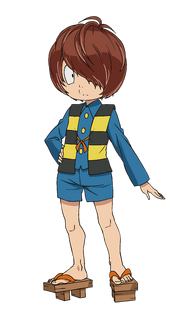 2018 anime art | |
| Name | |
| Japanese | 鬼太郎 |
| Alias | GeGeGe no Kitarō (ゲゲゲの鬼太郎) |
| Profile | |
| Species | Yōkai |
| Gender | Male |
| Birth Date | February 30, 1954 |
| Height | 130cm |
| Weight | 30kg |
| Home | GeGeGe Forest |
| Affiliation | Ghost Tribe Kitarō Family |
| Family | Medama-Oyaji (father) Iwako (mother) |
| Powers | |
| Abilities | Hair Needles Finger Guns Yōkai Antenna Regenerative powers Electrical powers |
| Weapons | Chanchanko Remote Control Geta Yōkai Ocarina |
| Super special power | Tolerating Nezumi-Otoko more than most others |
| First Appearance | |
| Manga | The Birth of Kitarō (1960) |
| Anime | Series 1 Episode 1 (1968) |
| Portrayals | |
| see Cast | |
| [v · t · e] | |
Kitarō (鬼太郎, Kitarō), also known as GeGeGe no Kitarō (ゲゲゲの鬼太郎), is a yōkai boy born in a cemetery after the death of his parents. Aside from his mostly-decayed father, Medama-Oyaji, he is the last surviving member of the Ghost Tribe. He fights for peace between humans and youkai, which generally involves protecting the former from the wiles of the latter.
His name comes from a pre-war era picture story show entitled Hakaba Kitarō, featuring a character with a similar backstory. Shigeru Mizuki gives credit to author Masami Itō for inspiring the character of Kitarō.
His birth year is 1954, but his birth day is unknown (he claims it to be February 30th in the 1968 anime). His father is Medama-Oyaji, and his mother is Iwako.
Cast

Kitarō (by Shigeru Mizuki)
- Anime
- Masako Nozawa
- Keiko Toda (3rd & Bingo 5 commercials)
- Yōko Matsuoka (4th)
- Minami Takayama (5th)
- Miyuki Sawashiro (6th)
- Mika Kanai (Shigeru Mizuki's Yōkai Gadan)
- Live Action
- Video Games
Origin
Hakaba Kitarō
The original kamishibai that inspired Kitarō was first written around 1933 or 1935 by Masami Itō. Because the original art has been lost since the war not much is remembered about the story. What is recalled is that it told the story of a horrid looking child (or snake-like child) being born out of a graveyard after his parents' deaths and seeking revenge on their enemies.
He is also likely inspired by ghost stories such as those about Kosodate-Yūrei.
Mizuki's Kamishibai
Mizuki began using the character that would become Kitarō in 1954 in various kamishibai stories, including Serpent Man, Karate Kitarō, Gallois and Ghost Hand. While Itō's kamishibai wrote the name Kitarō as 奇太郎, Mizuki wrote the name as 鬼太郎, using the character for devil for Ki.
However, Kitarō's background in these stories is quite different from the Kitarō to come. In Serpent Man, Kitarō is a human born from the belly of snakes who seeks revenge on those who mistreated him as a child. In Karate Kitarō, he trains under a karate master named Gichin (modeled after real-life karate master Gichin Funakoshi) and eventually faces him in battle and defeats him.
Rental Manga
- Main article: The Birth of Kitarō
In 1960, Mizuki introduced Kitarō in the rental manga story The Ghost Family. It is here that Kitarō's official backstory is established. In The Ghost Family, Kitarō is a yōkai child born out of a graveyard after his mother dies.
Appearance
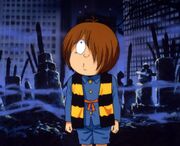
Kitarō's clothes are based off of an old Japanese school uniform.
Kitarō looks like a young boy. He has long brown hair which covers his left eye, and he wears a black and yellow striped chanchanko over a navy blue Showa-era school uniform. He also wears Japanese style wooden sandals, called geta. His school uniform was made out of the beard of a wizard and has lasted over 100 years. His undergarments concsist of a shirt made out of a water nymph's robe and an oni loincloth Medama-Oyaji claims to have gotten from Momotarō. He is modeled after Mizuki's nephew when he was 3 or 5.
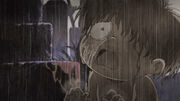
Kitarō lost his eye by hitting a gravestone.
His hair is light gray in the original manga, but from the 2nd anime on it is brown.
He is missing his left eye. The origin behind this varies depending on the story. In the Hakaba Kitarō manga, it is just assumed he hurt his eye while climbing out of the grave, but in the Hakaba Kitarō anime it is explained that after he emerged from the graveyard, a terrified Mizuki threw him away and ran, and the infant Kitarō hit his eye against the edge of a grave stone. In the rental manga, Kitarō is sometimes depicted missing his right eye instead. It was also common for Medama-Oyaji to rest in the empty socket and emerge from Kitarō's bangs, usually startling people. After the GeGeGe no Kitarō era began, whether or not Kitarō was missing an eye depended on the adaptation.
In the live action films starring Eiji Wentz, Kitarō is 170cm and wears a black uniform with silver hair.
Personality
Kitarō is usually cool and collected, but he also has a strong sense of justice and can be very passionate. Because of this, he has a good-natured side that can't ignore the plights of people or yōkai. He even forgives Shūichi Yamada for transforming him into the Dai Kaijū. In the story Umibōzu-sensei he proclaims to be swayed by "love and justice" (this was said in retaliation to Nezumi-Otoko, who had asked him to stop saying lines he probably heard in a cheap movie somewhere). He dislikes anyone who commits or aides in bad deeds and has even punished humans on occasion. However, in the rental manga his compassion was very weak, and he is depicted as leading a creepy life tricking humans into misfortune. He also has a soft spot for both human and yōkai girls, and sometimes gets tricked by them. This aspect of his personality was also depicted in the 3rd and 5th anime as well as the live action movies.
Over the course of the anime series, his personality has changed slightly.
1st & 2nd anime
He is basically the same character as in the manga, with more emphasis on his sense of justice. The 1st anime also gave him a more childlike personality, while the 2nd series made him a bit more mature.
3rd anime
Kitarō's sense of justice and passionate personality are at their strongest here. His weakness for pretty girls is also established here. Compared to the rest of the franchise he is far more active, with only fragments of his calmer, gloomier personality from the manga showing. Though he greatly wishes for coexistence between humans and yōkai, he can deal pretty severe punishments, such as when he struck Yamada repeatedly for turning him into the Dai Kaijū.
4th anime
Because of the more laid back style of the series, he is a lot calmer and has a dry side to him. Because of this, there are more cases where he forgives yōkai without defeating them. He also no longer has a weakness for pretty girls and instead is more gentlemanly. He usually stays calm even when angered but has some moments where reacts more violently, such as when he attacked Wanyūdō with a lead pipe for turning Neko-Musume into a diamond and eating her soul[1] and when he struck Genzō Furunoguni for badmouthing Anagura-Nyūdō after he sacrificed himself to save humans.[2] However, he does still have the occasional comedic moments.
5th anime
Depicted now as eternally a young boy, Kitarō still has a sense of justice and a child-like side, but is now more cynical. In contrast to the previous anime adaptations, his desire for humans and yōkai to co-exist is significantly weaker and he is more willing to punish humans who commit wicked deeds, especially if children are involved. However, he still has comical moments and can be pretty easy-going. His weakness for pretty girls is also revived. When Gorgon failed to absorb the evil from Kitarō's soul, Konaki-Jijii proclaimed that Kitarō possessed "a heart that doesn't lean toward good or evil". A flashback in Ep. 85 revealed that as a child, his yōkai power was so wild he destroyed an entire village.[3] He was calmed then by Aobōzu, and from that moment on looked up to Aobōzu like an older brother, even calling him Ao-niisan (蒼兄さん, Big Bro Ao).
6th Anime
In the 6th anime he has an aloof and blunt personality, rarely changing his facial expressions. Other than the Hakaba anime, this is the first series that references him being raised by Mizuki and it is said that he helps humans to return the favor. Other than this, he is shown to be quite cold and antisocial towards humans. Under the opinion that too much exposure to yōkai is not good for humans, he tries his best to avoid the human world as much as possible.
Family
Kitarō is the last descendent of the Ghost Tribe, which is a tribe of yōkai rather than literal ghosts. Although in the manga GeGeGe no Kitarō: Jigoku Hen (and it's susbsequent anime adaptation) he is said to be the son of a yōkai father and a human mother, this lineage has never been used another adaptation.
- Father - Medama-Oyaji
- Mother - Iwako
- "Uncle" - Kemedama
History
Kitarō's mother, Iwako died while she was still pregnant with him, and she and his father were buried by the blood banker Mizuki. But three days later, Kitarō crawls out of her womb and the grave by his own power. His birth story is usually not depicted in the anime series, with the exceptions of the 3rd[4], 4th[5], and Hakaba Kitarō anime[6].
After his birth he is taken in by Mizuki, but Kitarō treats him coldly and runs away at age 6, leaving on an aimless journey with his reanimated father (see Medama-Oyaji), eventually settling with a peaceful life in GeGeGe Forest. As a child, he attended Yōkai Elementary with Neko-Musume. According to Nezumi-Otoko, Kitarō attended the Yōkai Study Hall with him. In the live-action movies he is said to have attended a semester at Under the Grave Middle School.
Day to Day Life
Kitarō usually lives together with Medama-Oyaji in a tree house commonly referred to as the GeGeGe House, although in the manga chapter Shinigami he lives in Sunakake-Babaa's Yōkai Apartments. Because he owns various Human World goods it seems he has money, but this is never made clear. He essentially lives a poor life, and in the original manga he is seen rummaging through garbage cans. In the serialized mangas and the animes, he doesn't usually receive a reward whenever he solves incidents, at most he will receive free food and bedding whenever he stays with someone. Some clients will offer him a large monetary reward, but he usually recommends they put that money towards hospital bills or, if such is the case, offerings to the yōkai they disturbed.
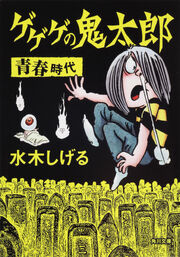
Kitarō as he appears in Zoku GeGeGe no Kitarō
The manga series Zoku GeGeGe no Kitarō depicts Kitarō's adolescence . In this series, welfare officer Mansuke suggests to him that "this is an era where yōkai and humans can co-exist". At Mansuke's advise, Kitarō integrates into human society and works various part-time jobs for income. At first he rooms with a poor painter, but the painter finds him annoying and kicks him out. He is then reunited with Nezumi-Otoko for the first time in 7 years and lives with him in a haunted house. Hiding his Ghost Tribe lineage, he poses as a human named Getakichi Tanaka (田中 ゲタ吉, Tanaka Getakichi) and attends Under the Grave High School. He also obtains a human girlfriend named Yuriko. This series also saw Kitarō taking part in seedier elements of human society, such as sex and greed. However, Shigeru Mizuki later felt "bringing sex to Kitarō was a mistake", and so in Shin GeGeGe no Kitarō Kitarō has abandoned his human life and moved to the mountains. By Dai Bora Kitarō, Kitarō's adolescence had been retconned and he was depicted as a young boy again.
Relationships
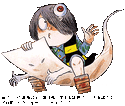
|
This article is a stub. You can help the GeGeGe no Kitarō Wiki by expanding it. |
Medama-Oyaji
Nezumi-Otoko
Neko-Musume
Nurarihyon
Yumeko Tendo
Mana Inuyama
Image Songs
- Kitarō Ondo by Keiko Toda (1985 anime)
- Moero! Kitarō by Keiko Toda (1985 anime)
- Itazura by Minami Takayama (2007 anime)
Trivia
- Gegege no Kitarō is the mascot for the Gainare Tottori soccer club. Additionally, J.League Division 1 team F.C. Tokyo also holds "Gegege no Kitarō Day" every season.
- In Episode 6 of the Japanese drama Hana-Kimi, the protagonist Ashiya Mizuki (Horikita Maki) is quoted as saying that Izumi Sano (Oguri Shun) looks like "Kitarō", due to the way Sano's hair is styled. Sano then said that Mizuki must be "Medama Oyaji", since Mizuki always has 'his' eye on Sano. Also, in Episode 7, Noe greets the assembled couples on their way to the roof of the school on the evening of the delayed star festival (August 7) dressed as Kitarō and holding a figure of Medama Oyaji bathing in a rice bowl.
- The exclamation "GeGeGe no Ge!" is used by ShogunGekomon in Episode 15 of Digimon Adventure 02.
- In the last chapter of the manga, Ikujinashi Shiawase (Happiness of a Cowardly Boy) by Naono Bohra, character Kawada is embarrassed to look at the face of his lover, Mori, after Mori gets a haircut. Kawada complains that with his new haircut, Mori's handsome face is "too exposed" and attracts too much attention from other people. He states that Kawada used to have hair like "GeGeGe Kitarō", and he preferred it that way since his face was half-hidden most of the time.
- Japanese musician Miyavi has also described his hairstyle as a Kitarōu-cut many times (i.e.: official profile, diary, etc...).
- Shigeru Mizuki has issued a series of limited-edition woodblock prints entitled "Fifty-Three Stations of the Yokaido Road", re-interpreting the famous Hiroshige series "Fifty-Three Stations of the Tokaido Road" as "a haunted journey". Printed from Mizuki's original paintings, the "Yokaido Road" prints star Kitarō and his troupe, as well as many other yokai and weird creatures of folklore. Produced through the Japanese publisher Yanoman Corporation, in March 2008 the series went on display in the Information and Culture Center of the Japanese Embassy in Washington DC.
- In the Kamen Rider Den-O OVA spin off, Imagin Anime, Ryutaros refers to the show. When the other Tarōs attempt to sing the first part of the series' main theme, Deneb stopped them from getting sued from the mere mention of it by name.
- In The Great Yokai War, after Tadashi first realizes Sunekosuri is a Youkai, goes out to look at the yokai models, statues of Kitarō and Konaki-Jijii are shown. Later, after a Youkai meeting ends up with their supposed help deciding to aid them, Kawataro the Kappa and Ittan-momen to a pillar while chiding "You're always real brave with Kitarō in those comics!" Kitarō's creator Shigeru Mizuki also appears in a cameo role in the film near the end.
- Main Mushishi character Ginko bears uncanny similarities to Kitarō. Both have similar hairstyles, pale complexions and a missing left eye (this occurs to Ginko in Episode two). The only differences occurring are eye color and hair color. It should also be noted that both series deal with supernatural occurrences.
- The Shaman King character Manta also bears a resemblance to Kitarō.
- In a manga called Miyuki, the character Inoue who appears in chapter 55. bears a striking resemblance to Kitaro in both appearance and personality.
- The protagonist Kubo from the movie "Kubo and the Two Strings" could be reference to Kitaro, due to some similarities to the two.
References
| | |
|---|---|
| Ghost Tribe | Kitarō • Medama-Oyaji |
| Other members | Nezumi-Otoko • Neko-Musume • Sunakake-Babaa • Konaki-Jijii • Ittan-Momen • Nurikabe |
| Former members | Shisa • Yuki-Hime • Netarō |
| Recurring allies | Yobuko • Kasa-Bake • Abura-Sumashi • Tsurube-Bi • Bake-Garasu |
| Yōkai Apartments | Nekoko • Kamikiri • Azuki-Arai • Akaname • Tsurube-Otoshi • Gyūki |
| Yōkai Yokochō | Kawauso • Amabie • Rokuro-Kubi • Ohaguro-Bettari • Nurikabe-Nyōbō & Ko-Nurikabe |
| Other Allies | Maruge • Ido-Sennin • Bake-Kujira • Yagyō-san • Aobōzu • Simurgh • Agnès |
| Tendo Family | Yumeko Tendō • Hoshirō Tendō • Masao Tendō • Yūko Tendō |
| Elementary School Trio | Yūko Murakami • Shōta Suzuki • Jun Tanimoto |
| Others | Mizuki • Makoto Washio • Mana Inuyama |
| See also | |
| 47 Yōkai Warriors | |






